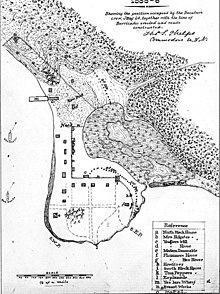Puget Sound War
| Puget Sound War | |||||||
|---|---|---|---|---|---|---|---|
| Part of the American Indian Wars | |||||||
 A map of Seattle, drawn at the time of the Battle of Seattle, part of the Puget Sound War. Map shows the sloop USS Decatur and the bark Brontes in Elliott Bay |
|||||||
|
|||||||
| Belligerents | |||||||
|
Snoqualmie |
Nisqually Muckleshoot Puyallup Klickitat |
||||||
| Commanders and leaders | |||||||
|
|
Chief Leschi | ||||||
| Units involved | |||||||
|
9th US Infantry 3rd US Artillery 4th US Infantry USS Decatur Snoqualmie warriors Washington militia Oregon militia |
Nisqually warriors Muckleshoot warriors Puyallup warriors Klickitat warriors |
||||||
The Puget Sound War was an armed conflict that took place in the Puget Sound area of the state of Washington in 1855–56, between the United States military, local militias and members of the Native American tribes of the Nisqually, Muckleshoot, Puyallup, and Klickitat. Another component of the war, however, were raiders from the Haida and Tlingit who came into conflict with the United States Navy during contemporaneous raids on the native peoples of Puget Sound. Although limited in its magnitude, territorial impact and losses in terms of lives, the conflict is often remembered in connection to the 1856 Battle of Seattle and to the execution of a central figure of the war, Nisqually Chief Leschi. The contemporaneous Yakima War may have been responsible for some events of the Puget Sound War, such as the Battle of Seattle, and it is not clear that the people of the time made a strong distinction between the two conflicts.
The Puget Sound War began over land rights and ended in a cloud of controversy surrounding the hanging of Leschi.
The catalyst of the war was the Treaty of Medicine Creek of 1854. Negotiated by Washington Territory Governor Isaac Stevens, the treaty preserved Indian fishing rights, but took away prime Nisqually farm land. Leschi, chosen to negotiate the treaty with Stevens, was outraged and chose to fight rather than give up his land. The fighting commenced in October 1855, when “Eaton’s Rangers,” a citizen militia under Captain Charles Eaton, were involved in a clash with Nisqually tribesmen. Two militiamen, Joseph Miller and Abram Benton Moses, were killed. Upon hearing the news, Governor Stevens immediately dispatched a company to locate Leschi and “escort” him back to Olympia.
...
Wikipedia
